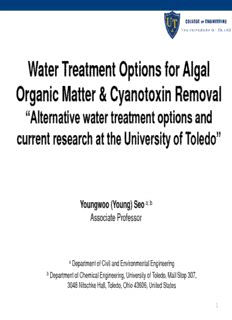
Water Treatment Options for Algal Organic Matter & Cyanotoxin Removal PDF
Preview Water Treatment Options for Algal Organic Matter & Cyanotoxin Removal
Water Treatment Options for Algal Organic Matter & Cyanotoxin Removal “Alternative water treatment options and current research at the University of Toledo” Youngwoo (Young) Seo a; b Associate Professor a Department of Civil and Environmental Engineering b Department of Chemical Engineering, University of Toledo, Mail Stop 307, 3048 Nitschke Hall, Toledo, Ohio 43606, United States 1 Contents 1. Backgrounds 2. Available Technologies 3. Current Research at UT 4. Collaboration Opportunities 5. UT Water Treatment Research Lab 2 Toxic Harmful Algal Bloom (HAB) The global occurrence of Harmful Algal bloom (HAB) Cyanobacteria Strains & Associated Toxins http://epa.ohio.gov/Portals/28/documents/habs/toxin_producing_cyanobacteria.pdf Cyanotoxins Cyanotoxin classification and their respective mode of action Appl Microbiol Biotechnol (2014) 98:8073–8082 Microcystin-LR Microcystin-LR (MC-LR) Produced as secondary metabolites by cyanobacteria Stable in water and resistant to Hydrolysis, Oxidation and High Temperature MC-LR Hepatotoxin ( liver damage/ liver tumor promoter ) Drinking water guidance value by World Health Organization (WHO) : 1 μg/L 6 Ho et al, Water Res 2012,46, (5), 1536-48; Liang et al, J of Hazard Mat 2016,301(15)381–399 Microcystin Incident by State 7 WaterResearchFoundation2014 WRF Webcast Treatment for Cyanobacteria Toxins Toxins in Cells Dissolved Toxins • Particle removal processes are • Particle removal processes not effective • Minimize cell lysis and toxin • Typical disinfectants may not be releases effective • Major water treatment plant improvements with high costs (e.g. ozone and/or GAC) 8 Controlling Methods for Microcystins KMnO Ozonation UV/H O 2 2 4 Optimization Membrane Filtration Biological Filtration 9 Potassium Permanganate Optimization Study Objectives Algal Organic Matter (AOM) KMnO Pretreatment 4 Maximum dose? Drinking Water Damage algal cell ? Treatment Plant Release of toxins (microcystin-LR) ? Lower DBP precursors? Taste and odor problems Precursors of Disinfect Byproducts (DBPs) ? Algal toxin release
Description: